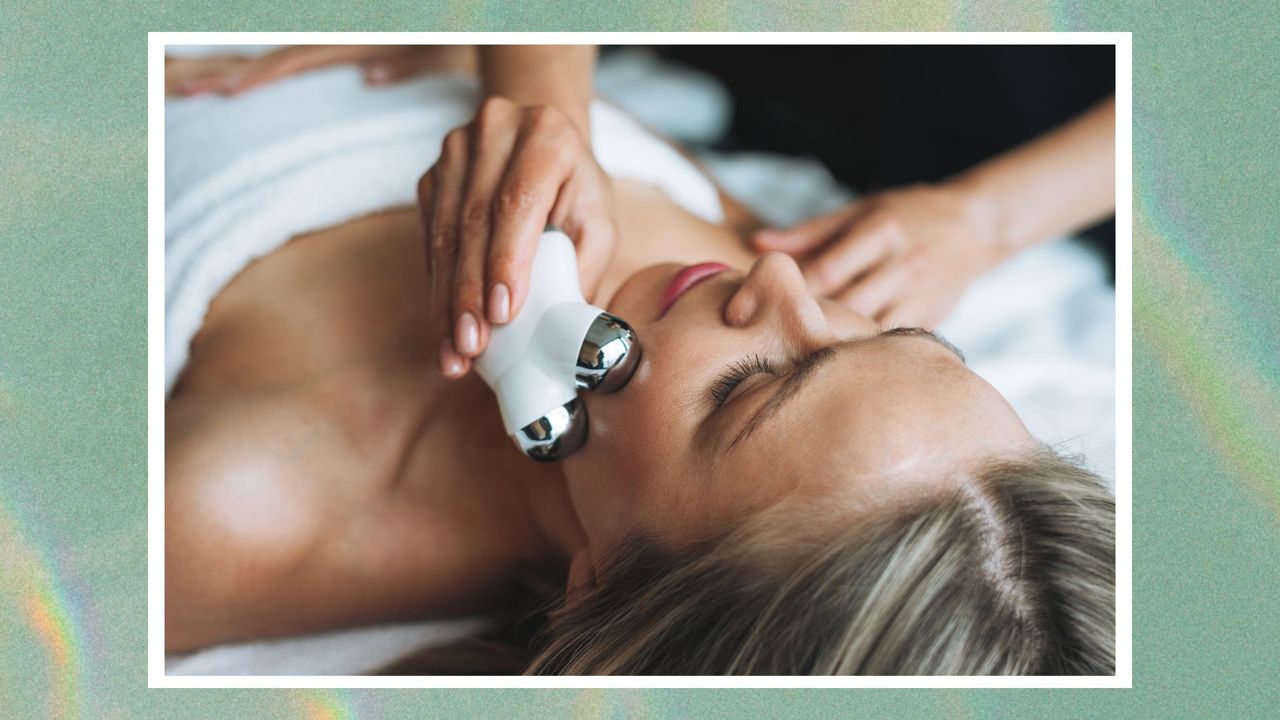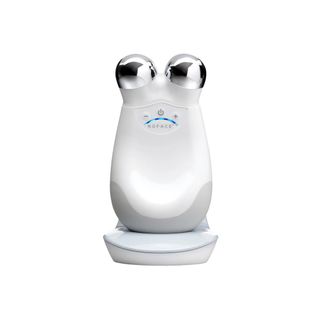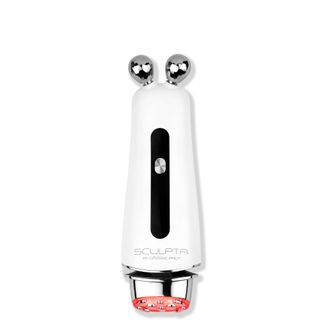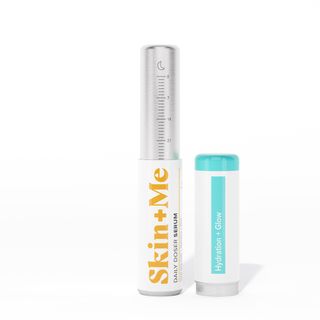Everything you need to know about microcurrent facials
Dubbed a ‘non-invasive facelift’, is this treatment the secret to looking more snatched?


The face-firming effects of microcurrent facials are well documented. A quick search on Google, and you’ll see endless ‘before and after’ photographs, showcasing the impressive results. Lifting and enhancing the contours of the face, the treatment involves the use of a high-tech device that delivers a bolt of electrical current through the skin to stimulate and tone facial muscles.
Not exactly new, microcurrent – like red light therapy and microneedling – has been around for decades. “Microcurrent technology was first developed in the medical field to aid in the treatment of muscle paralysis,” says Dr David Jack, aesthetic doctor and founder of his eponymous skincare line. It was used to stimulate neuromuscular pathways, helping to retrain and strengthen weakened muscles resulting from nerve injuries. “The technology was adapted for aesthetics many years ago – probably as early as the 1980s,” continues Dr Jack.
Said to aid lymphatic drainage, boost collagen and reduce the appearance of fine lines, it’s now an incredibly popular treatment (both at-home and in the clinic). Tempted to try? Here, the experts reveal everything you need to know, from how the technology works to whether it really makes a difference in the long-term.
Everything you need to know about microcurrent facials, according to the pros
What does a microcurrent facial do?
“Think of it as a workout for your face, without the sweat,” says Sadaf Jaffari, consultant aesthetician, “whereby your facial muscles are stimulated via an electrical current.” Dr Sophie Shotter, aesthetic doctor and founder of Illuminate Skin Clinic, explains that “this current will travel between the two electrodes of the device to give some muscle stimulation which can lead to a temporary lifting effect.” The results? “An instant lift and a youthful, fresh look that keeps improving with regular sessions,” says Jaffari.
How does microcurrent work?
Microcurrent works by applying gentle, low-voltage electrical currents that mimic the body’s natural electrical signals. “These currents stimulate the facial nerves, causing subtle muscle contractions that help enhance muscle tone,” explains Dr Jason Thomson, dermatologist and Head of Medical at Skin + Me.
Appealing to people looking to non-invasive procedures for lifting effects, microcurrent has been dubbed ‘a non-surgical facelift’. “Unlike Botox, which paralyses muscles by blocking nerve signals, microcurrent works to activate and tone muscles while preserving natural movement,” adds Dr Thomson.
Studies have shown that microcurrent also increases adenosine triphosphate (ATP) – the powerhouse molecule your cells use for energy. “More ATP means more fuel for your cells, leading to a production boost in collagen and elastin – two proteins essential for keeping skin firm and youthful,” adds Jaffari.
Sign up for the woman&home newsletter
Sign up to our free daily email for the latest royal and entertainment news, interesting opinion, expert advice on styling and beauty trends, and no-nonsense guides to the health and wellness questions you want answered.
What are the benefits of microcurrent?
Microcurrent gives an instant lift with zero down-time, but the benefits go beyond that. Ahead, Jaffari breaks down the full list:
- Lifts and tones: Microcurrent works your facial muscles, giving a toned, lifted look, almost like a mini facelift.
- Wrinkle reduction: By stimulating collagen and elastin, microcurrent can help smooth out fine lines and soften wrinkles.
- Boosts glow and de-puffs: The treatment boosts blood flow and lymphatic drainage, helping to reduce puffiness and brighten your complexion.
- Improves product absorption: After a microcurrent session, your skin is prepped to absorb skincare products even better, so they work their magic more effectively.
Dr Shotter does flag that the data supporting the claim that microcurrent can boost collagen production and ATP production is limited. “What we do know is that the microcurrent does boost blood supply to the skin itself, which also helps micronutrient and oxygen delivery, so skin will appear healthier and more radiant.”
Are microcurrent facials safe?
According to Dr Thomson, “microcurrent facials are generally considered safe when performed by trained professionals or when at-home devices are used as directed. The low-level current used is gentle and well-tolerated, with minor side effects, such as a slight tingling or temporary redness, that typically resolve quickly.”
However, there are certain individuals who should give it a miss. “It’s not suitable for those with pacemakers, epilepsy, or certain skin concerns, and pregnant individuals should consult a healthcare provider before use,” advises Dr Thomson.
How do at-home devices compare to in-salon treatments?
With demand comes supply and thanks to microcurrent’s in-clinic popularity, several at-home devices have recently landed on shop shelves. And though these savvy gadgets are impressive – they do differ from the devices used in-clinic.
“At-home microcurrent devices don’t quite match the strength or precision of professional in-salon equipment,” Dr Jack tells us. “Professional devices offer higher current levels and various waveforms to target specific muscle layers, achieving more noticeable results in a shorter timeframe.”
With that said, at-home devices have made this treatment more accessible and can be useful for maintaining results between professional treatments. “At-home devices are perfect for consistent upkeep and adding a little everyday glow – like keeping your step count up between gym workouts,” assures Jaffari.
How to use a microcurrent device at home
Begin by prepping the skin with your best cleanser to remove any oils or makeup, as these can interfere with conductivity. “A conductive gel is then applied to the skin to help the microcurrent reach the muscles effectively,” says Dr Thomson. For best results, “move your chosen device over the skin in slow, upward motions along the jawline, cheeks, forehead, and under-eye areas.”
Afterwards, Dr Thomson recommends applying a hydrating serum, like your best hyaluronic acid serum, or moisturiser to soothe the skin. “Avoid using active ingredients, like retinol, immediately after the treatment, as microcurrent may temporarily increase skin sensitivity. Also, regular cleaning of the device’s conductive prongs helps ensure optimal performance.”
Best at-home devices and aftercare...

RRP: £339
Perhaps the most iconic at-home microcurrent device, Nuface’s Trinity smooths fine lines, lifts brows and contours cheeks in five-minute treatment sessions. Use daily for best result.

RRP: £499
Expensive, yes. But this high-tech tool gets rave reviews with its multi-functional design that combines electrical muscle stimulation with radio frequency and red light therapy to treat fine lines and wrinkles, while also tightening and sculpting the face. Impressive, huh?
Emma Stoddart is a freelance beauty journalist and self-confessed skincare aficionado with over five years’ industry experience. Emma has worked for some of the UK’s top women’s titles including Net-A-Porter, Stylist and Grazia. Her experience spans online and print as well as producing editorial shoots with some of the industry’s biggest artists, including Val Garland. Asides from working with them behind the scenes, she’s also had the chance to interview the likes of Patrick Ta, Pat McGrath, and Sam McKnight for all their insider tips and tricks.
-
 Mesmerised by Stephen Graham and Erin Doherty in Adolescence? You need to watch A Thousand Blows
Mesmerised by Stephen Graham and Erin Doherty in Adolescence? You need to watch A Thousand BlowsThe pair worked together on the Disney+ series that should be your next must-watch if you were captivated by their performances in Adolescence
By Lucy Wigley Published
-
 Victoria Beckham washes her luxuriously glossy hair with this shampoo - because it 'smells incredible'
Victoria Beckham washes her luxuriously glossy hair with this shampoo - because it 'smells incredible'To cleanse, soften and prevent colour fade, we've discovered the exact haircare duo Victoria Beckham relies on
By Sennen Prickett Published

